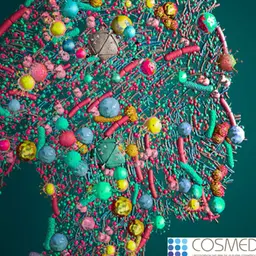
Almost a third of French people suffer from skin diseases: the French Society of Dermatology (SFD) has just unveiled the results of a survey launched in 2015 to assess the prevalence of skin diseases, but also their psychological, societal, and economic impact, as well as their consequences on the professional lives and leisure activities of the people affected.
The survey was conducted among a sample of 20,000 French people representative of the French population aged 15 and over. The main objective of the SFD is to communicate on the physical and mental burden ill people need to cope with to improve the way they are treated.
A few figures
Professor Khaled Ezzedine, an expert in the diseases related to pigmentation disorders and Dermatology Professor at the Créteil Henri Mondor Hospital near Paris, has revealed that ‘16 million French people suffer from skin diseases, i.e. one French person out of three. Women are more affected than men.’
The most common diseases are the following:
• Acne – 3.3 million people affected
• Eczema – 2.5 million people affected
• Psoriasis – 2.4 million people affected
• Diseases related to the scalp – 2.3 million people affected
• Mycoses – 2.2 million people affected
• Diseases related to nails – 2.1 million people affected
• Dark spots – 1.8 million people affected
• Warts – 1.7 million people affected
• Contact dermatitis – 1.3 million people affected
• Herpes – 1.2 million people affected
• Sun allergies – 1.2 million people affected
• Abnormal moles – 1.1 million people affected
Skin diseases: a real impact on the quality of life
Sociologist Stéphane Heas presented this aspect highlighted in the survey. He explained that ‘46% of the people affected by acne have already required work stoppage, 45.2% of the patients suffering from dermatitis say they suffer in their personal lives, and 39.2% of them feel uncomfortable in their professional lives.’ He added that ‘contrary to other ill people, those affected by skin diseases are shaken by the visible aspect of their disorders.’ In fact, skin diseases are visible; they are among the most stigmatizing and stereotyping pathologies. ‘It is not always easy to bear being looked at. Most often, patients also denigrate and exclude themselves. For more than half of them, it leads to depression and anxiety states. It is not rare for ill people affected by a chronic, incapacitating disease to consider suicide,’ Stéphane Heas emphasized.
In addition, he insisted on received ideas on these diseases. They are often little-known and have a bad reputation. As a result, it can take time for the people affected to go see a doctor, either because they are scared or ill-at-ease. Lastly, Stéphane Heas explained that ‘the later the diagnosis is made and the treatments prescribed, the heavier the consequences for patients. Fighting against medical trial and error is a seemingly impossible task. A patient that does not know which way to turn is a patient that suffers, but also a patient that multiplies medical appointments everywhere, wastes their time and money (and that of Social Security), gets lost and desperate. It is a double penalty, in a way.’ The tone is set – it is crucial to quickly go consult a health professional.
Hearing those that suffer
Jean-Marie Meurant, President of the Association Française du Vitiligo (French Vitiligo Association) and of the GlobalSkin International Alliance, suffers from a chronic skin disease himself. He has decided to fight and raise public awareness of the life conditions of French people suffering from skin pathologies. He explained that ‘these men and women’s daily lives are full of fear, isolation, and physical and psychological suffering. Today, 60% of ill people feel abandoned by the medical community.’ In addition, he called for all these people not to hide and live with shame. Two models suffering from vitiligo in the audience reacted to this exhortation, explaining they had made a living of their passion since they had decided to assert their pigmentation degeneration. They added that ‘they had become icons for people wearing makeup or using cosmetics to smooth out the visible signs of certain pathologies. Obviously, it is not easy for everyone to reveal themselves in the full light of day, so sometimes skincare products can provide comfort.’
This issue clearly sounds like a public health concern. In addition to having an impact on health (it should be said that many of these diseases are often associated with other factors of comorbidities like hypertension or diabetes), the psyche also suffers. With this survey, the SFD hopes to inform as many people as possible and alert public health players to prevent any tragedy.
To conclude, Professor Marie-Aleth Richard warned about the frequency of skin diseases, whose consequences are underestimated. She also insisted on the medical landscape, whose demographics have been declining. Today, there are about 3,500 dermatologists: ‘it is much too little to cover the demand, especially since the numerus clausus (quota) of students in medicine that can access this specialty gradually decreases.’ There has been a 9% decline in the number of people in this specialty in ten years. Only about 450 new dermatologists are trained every year, so there might soon be a lack of doctors available.
JS













